Women in the IT sector: peculiarities of labor supply (based on data from the Superjob digital platform)
The article identifies and examines the challenges facing women in the IT labour market, utilising the Superjob digital job search and employment platform as a case study. The study is relevant in light of the national priorities of accelerated and large-scale digitalisation of the economy and the social sphere, the need to ensure technological sovereignty, on the one hand, and the shortage of personnel and low levels of women's participation in the IT sector, despite the high attractiveness and socio-demographic efficiency of employment in this area, on the other hand. The paper presents the findings of an empirical study conducted on the basis of downloading data (resumes and job advertisements) from the widely used digital platform Superjob. A data set comprising 4,225 resumes and 2,533 IT vacancies posted on the Russian segment of the platform was subjected to analysis. The most in-demand professions in the IT sector are identified, as well as the level of women's participation in them, differences in the wages desired by applicants and offered by employers, the claims of men and women to the level of remuneration, employment regime and opportunities for an optimal combination of family responsibilities (personal life) with work. A comparison of the data obtained in this study with the results of other researchers' studies has revealed that the imbalance in the participation of men and women in the modern and growing field of IT is still present and persistent. Furthermore, these differences are not always the result of external factors, such as employer preferences. Rather, they are often determined by latent factors, including the internal mechanisms of self-positioning of men and women in society and, in particular, in the labour market. Additionally, stereotypes and attitudes that are formed and broadcast in the family and school environment also play a role.
Figures
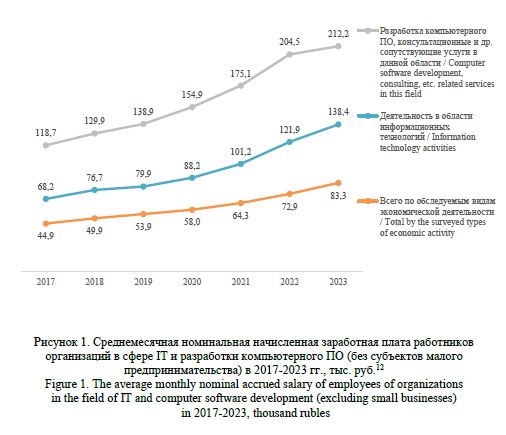
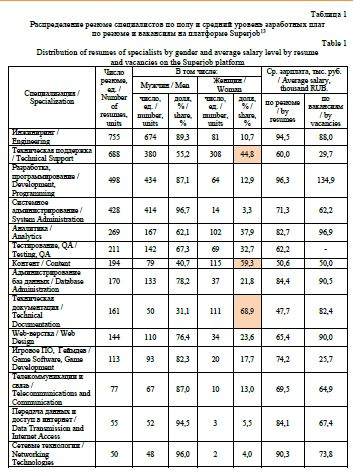
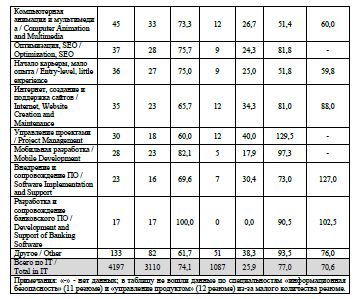
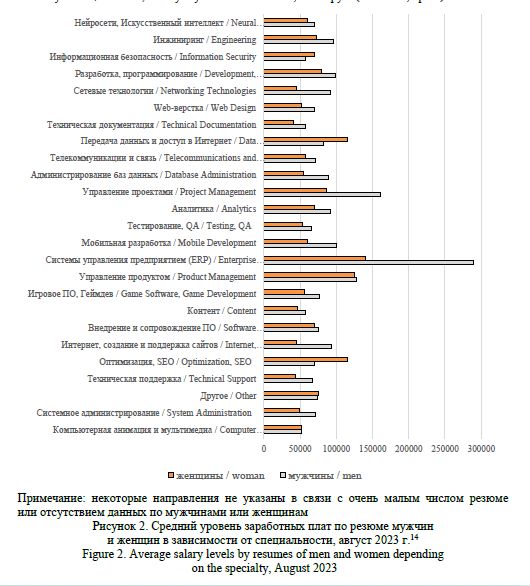


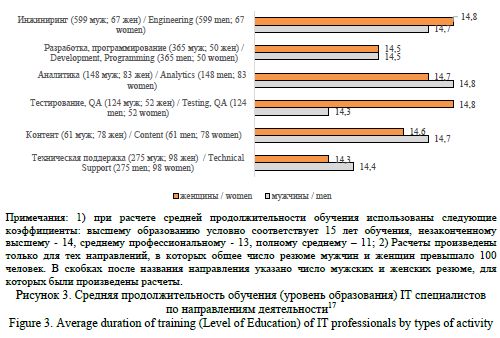
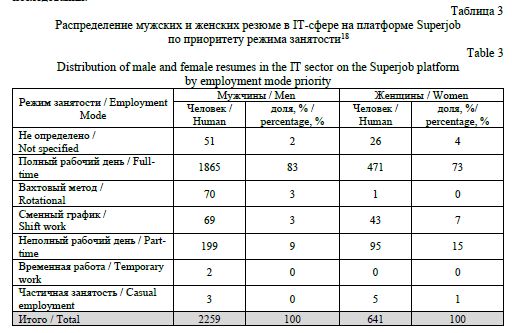
Baimurzina, G. R., Leonidova, G. V., Battalova, A. I. (2024), “Women in the IT sector: peculiarities of labor supply (based on data from the Superjob digital platform)”, Research Result. Sociology and Management, 10 (4), 207-225 . DOI: 10.18413/2408-9338-2024-10-4-1-1
Research result. Sociology and Management is included in the scientific database of the RINTs (license agreement No. 765-12/2014 dated 08.12.2014).
Журнал включен в перечень рецензируемых научных изданий, рекомендуемых ВАК







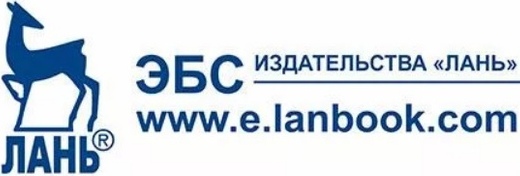
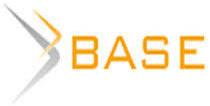









While nobody left any comments to this publication.
You can be first.
Ahmadullin, A. R. (2015), “Features of personnel and the specifics of labor activity in the information technology industry as the basis for increasing the competitiveness of personnel”, Vestnik Universiteta, (13), 165-171. (In Russian)
Zemnukhova, L. V. (2013), “IT-workers at the labour market”, Sociologija nauki i tehnologij, 4 (2), 77-90. (In Russian)
Kamarova, T. A. and Baranova, N. V. (2022), “Assessing the development of digital employment in the labor market on the example of the IT sector: Basic metrics”, Jekonomicheskie i social'nye peremeny: fakty, tendencii, prognoz, 15 (6), 199-214, DOI: https://doi.org/10.15838/esc.2022.6.84.12. (In Russian)
Klimova, Yu. O. (2020), “Analysis of staffing in the information technology industry at the federal and regional levels.”, Herald of Omsk University. Series “Economics”, (1), 126-138, DOI: https://doi.org/10.24147/1812-3988.2020. (in Russian).
Netreba, P. N., Katkova, E. V., Eremina, N. I., Asaturov, R. B. and Kirillova, A. A. (2022), “IT industry: human resources”, Jekonomika Rossii: aspekty global'nogo transformacionnogo sdviga [The Russian Economy: aspects of the global transformational shift], in Netreba, P. N. and Orekhin, P. V. (eds.), HSE University, Moscow, Russia. (in Russian).
Novikova, E. V. and Pshenichnikov, N. V. (2022), “Modern trends of the Russian labour market in the field of information technology”, Jekonomika truda, 9 (6), 1019-1030, DOI: https://doi.org/10.18334/et.9.6.114934. (in Russian).
Rostovskaya, T. K., Shabunova, A. A. and Bagirova, A. P. (2021), “The concept for corporate demographic policy of Russian enterprises in the framework of corporate social responsibility”, Jekonomicheskie i social'nye peremeny: fakty, tendencii, prognoz, 14 (5), 151-164, DOI: https://doi.org/10.15838/esc.2021.5.77.9
Abdrahmanova, G. I., Zinina, T. S., Kovaleva, G. G. and Frolov, M. S. (2022), Sektor IKT v 2021 godu: na pike rosta v preddverii novyh uslovij: jekspress-informacija ISIJeZ NIU VShJe [The ICT sector in 2021: at the peak of growth in anticipation of new conditions: Express information of the HSE University], 56 (240), [Online], available at: https://issek.hse.ru/news/655861546.html (Accessed 29 October 2024).
Sushko, P. E. (2019), “IT workers on the Russian labor market: the contours of the group and their place in the employment structure”, Budushhee sfery truda: global'nye vyzovy i regional'noe razviti [The Future of work: global challenges and regional development], collection of articles of the International Forum Future of work: decent work for all], in Baimurzina, G. R., Valiakhmetov, R. M. (eds.), Mir Pechati, Ufa, Russia, 238-242. (in Russian)
Tomakova, R. A. and Tomakov V. I. (2022), “The Russian Labor Market in the Information Technology Industry in 2021”, Izvestija Jugo-Zapadnogo gosudarstvennogo universiteta. Serija: Jekonomika. Sociologija. Menedzhment, 12 (1), 150-166, DOI: https://doi.org/10.21869/2223-1552-2022-12-1-150-166. (in Russian).
Chernykh, E. A. (2021), “Socio-demographic characteristics and quality of employment of platform workers in Russia and the world”, Jekonomicheskie i social'nye peremeny: fakty, tendencii, prognoz, 14 (2), 172-187, DOI: https://doi.org/10.15838/ esc.2021.2.74.11. (in Russian).
Khasbulatova, O. A. and Smirnova, I. N. (2020), “Gender stereotypes in digital society: modern tendencies”, Narodonaselenie, 23 (2), 161-171, DOI: https://doi.org/10.19181/population.2020.23.2.14. (in Russian).
Patel, R., Parmentier, M. J. C. (2005), “The Persistence of Traditional Gender Roles in the Information Technology Sector: A Study of Female Engineers in India”, Information Technologies and International Development, 2 (3), 29-46. DOI: https://doi.org/10.1162/1544752054782457.
Sharma, S. and Nagaich, S. (2017), “Does the Gender Matters in IT Industry”, Electronic Journal, DOI: http://dx.doi.org/10.2139/ssrn.3092088.
Singh, V. K., Chayko, M., Inamdar, R. and Floegel, D. (2020), “Female librarians and male computer programmers?”, Gender bias in occupational images on digital media platforms, 71 (11), 1281-1294, DOI: https://doi.org/10.1002/asi.24335.
Alekseeva, L., Azar, J., Giné, M., Samila, S. and Taska, B. (2021), “The demand for AI skills in the labor market”, Labour Economics, 71, DOI: https://doi.org/10.1016/j.labeco.2021.102002
Tokbaeva, D. and Achtenhagen, L. (2023), “Career resilience of female professionals in the male-dominated IT industry in Sweden: Toward a process perspective”, Gender, Work & Organization, 30 (1), 223-262, DOI: https://doi.org/10.1111/gwao.12671.
Trout, E. and Connolly, R. (2021), “Exploring the nature of changes in factors affecting gender equality in IT: A longitudinal study of women in Ireland”, MIS Quarterly, 45 (4), 2055-2100, [Online], available at: https://aisel.aisnet.org/misq/vol45/iss4/18/ (Accessed 29 October 2024).
Zhang, Y., Gros, T. and Mao, E. (2021), “Gender Disparity in Students’ Choices of Information Technology Majors”, Business Systems Research, 12 (1), 80-95, DOI: https://doi.org/10.2478/bsrj-2021-0006.
The research is funded by the Russian Scientific Foundation “Informal Employment in Russian Regions: Social Risks and Opportunities” for 2023-2025 (Project № 23-18-00775).